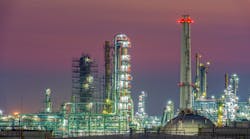Achieving low energy intensity requires pairing low energy consumption with high production rates:
Energy Intensity = Energy Consumption/Production
We discussed this concept in last month’s column (see, “Low Rate, Low Efficiency”), and applied it specifically to the impact of production rate cuts on energy intensity. This month, we turn to another ramification of this simple equation: The beauty of the steady state. In general, if you keep plant conditions stable, energy intensity is low. Stable operation often also yields other benefits, such as high production, enhanced product quality and increased profitability.
Guest contributor Charles Herzog touched on this concept in February’s “Improve Distillation Control”, where he discussed the control of distillation columns. Disturbances often result in either the overhead or bottom product going off-spec. This raises energy intensity, either because of lost production (reducing the denominator in the equation), or because of the extra energy supplied to reprocess the off-spec material (increasing the numerator). We see similar effects in many other situations, including:
Minor maintenance. This involves activities such as onstream cleaning of heat exchangers. As this temporarily removes heat recovery equipment from service, there is a direct and obvious adverse impact on energy intensity. However, routine preventive maintenance on other equipment, as well as breakdown maintenance, and a host of other activities, can also affect energy intensity. Shutting equipment down for maintenance, and bringing it back online, both create disturbances. In addition, throughput often decreases while the equipment is offline for maintenance. All of these factors increase energy intensity.
Partial shutdowns. These “squats” are needed for some more-complex maintenance activities, or to recover from major plant upsets. Sections of the plant are idled, and production is either greatly reduced or completely stopped, but as much as possible, the plant is kept in a state that facilitates rapid restarting. This may include running distillation columns at total reflux, and recirculating product streams — activities that consume energy, with no net production — in addition to the effects noted last month for production cuts.
Total shutdowns. Necessary for major maintenance or upgrades, there is no production during the shutdown, and energy consumption is low, as most – if not all – of the plant’s equipment does not run. However, the procedures needed to shut down and later restart a large plant typically take several days. During this time, considerable energy is consumed (for example, in the controlled cool down and subsequent reheating of furnaces and other equipment), but very little usable product is produced, and off-spec product may have to be stored for subsequent reprocessing.
Product or grade changes. These may require, for example, blending different feedstocks, altering operating pressures and temperatures, and adjusting purity specifications. In some cases, transitions from one product or grade to another require a short shutdown, with the energy debits discussed earlier. Even when a shutdown is not necessary, the period of disturbance during the transition also increases energy intensity.
Weather and natural disasters. Daily temperature cycles disturb operations on many plants. Torrential rainfall can have a much more serious impact, as discussed in Herzog’s column. Extreme events, such as hurricanes, can cause major disruptions, damaging equipment and shutting plants down. In these situations, we tend to focus on the cost of repairs and the loss of production. However, as with any other shutdown, an adverse impact on energy intensity also occurs. In addition, debits may accrue due to abnormal operating conditions both prior to and after the shutdown (e.g., operation at reduced throughput due to supply chain problems).
Batch plants. By design, they operate with continuously changing conditions and stoppages between batches. Consequently, batch processes are inherently less energy-efficient than continuous ones.
We cannot totally eliminate disturbances, but ways to minimize their impact can include:
• Insulate equipment to mitigate the effects of ambient temperature changes and rainfall.
• Provide surge capacity in feed and product drums, to better manage composition changes.
• Upgrade control systems.
• Minimize the frequency of grade and product changes.
• Modify startup and shutdown procedures to eliminate unnecessary delays — subject, of course, to all safety and equipment integrity requirements.
• Where possible, design processes for continuous rather than batch operation.

